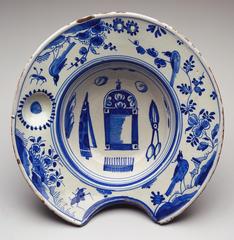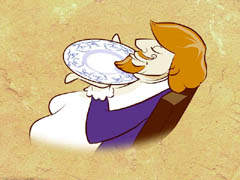
This seventeenth-century English barber's bowl was once an essential tool for a barber shaving his customers. It has a shallow basin with a broad rim. A semicircular opening in the rim allows it to fit closely against the neck of the person being shaved, permitting his chin to reach over the bowl. The semicircular notch on the rim may also have been used for resting the patient's arm during the process of bloodletting, which was performed by barber-surgeons of the time. The small circular depression on the side of the rim may have held a small ball of soap while the barber lathered and shaved his customer's face. Another possibility is that the barber placed his thumb in the cavity to get a good grip while holding the bowl. One can only imagine that a firm grip by the barber on the wet, soapy bowl would be a comfort to the customer in the process of being shaved with a straight-edged razor. Many small chips and nicks along the outer edge of the rim suggest that this object was often employed in the shaving process.
The barber's bowl served another function as well. The two small holes on the top of the rim were used to string a cord from which the bowl was hung on the wall when not in use. The fact that it was hung on the wall shows that this bowl was also valued for its decorativeness. Although barber's bowls were most often made of tin-glazed earthenware, there are examples in pewter and brass and even silver.

Key ideas.
Where does it come from?
What does it look like?
How was it used?
How was it made?
How big is it?
Who Knows?
Additional resources.
|



